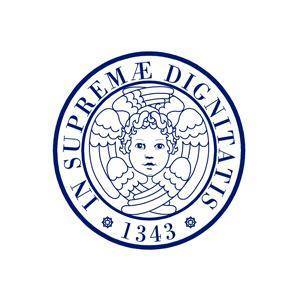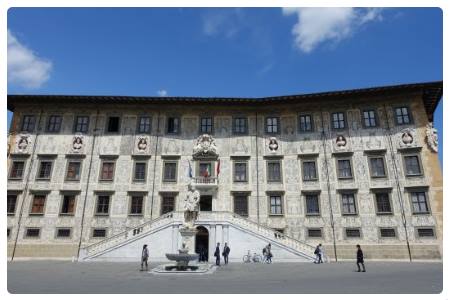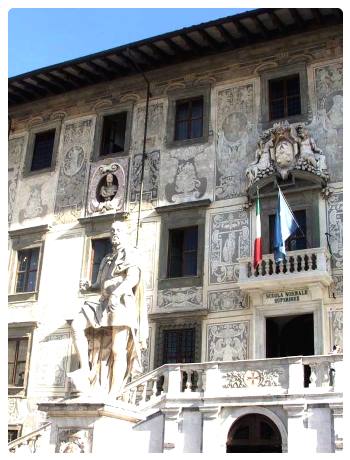|
You are here:
Italian universities
> University of
Pisa
|
The Academy of Studies
was founded in the second half of the twelfth century when Pisa, a city of great
Roman tradition and rich in intense economic life, had "legum doctores" and
schools of law, both secular and monastic. In the following century are also
reported the first testimonies of doctors "in arte medicinae et in arte
chirurgie".
|
|
 The
beginning of a real documented General Study dates back to 1338, when Count
Fazio della Gherardesca was the head of the municipality. In 1343, at
the behest of Pope Clement IV, a General Study was established in the
city with the following teachings: theology, canon law and civil law,
medicine "et qualibet alia licita facultate". In 1355 he followed the
diploma of recognition of Charles IV. Thus the University of Pisa
was born, as a place of study open to all, with a guild of teachers, precise
statutory rules governing the exercise of art, with legal recognition to
those who have followed the course of study, with the granting of the title
of "magister" or "doctor". The
beginning of a real documented General Study dates back to 1338, when Count
Fazio della Gherardesca was the head of the municipality. In 1343, at
the behest of Pope Clement IV, a General Study was established in the
city with the following teachings: theology, canon law and civil law,
medicine "et qualibet alia licita facultate". In 1355 he followed the
diploma of recognition of Charles IV. Thus the University of Pisa
was born, as a place of study open to all, with a guild of teachers, precise
statutory rules governing the exercise of art, with legal recognition to
those who have followed the course of study, with the granting of the title
of "magister" or "doctor".
 The
following period was characterized by an alternation of periods of glory and
periods of deep degradation, due mainly to the various wars with neighboring
cities, the internal struggles that troubled the city and the severe plagues
that devastated the entire country. Under the rule of the Medici, who
conquered the city, the university was reopened and Lorenzo dei Medici even
arranged the construction in a special building, the Sapienza, intended to
include not only the premises for the teachings of the various faculties,
but also the residential premises of teachers and students. Following the
rebellion of the city against the Florentine ruler, the University was
transferred to Florence and reopened in 1515. The
following period was characterized by an alternation of periods of glory and
periods of deep degradation, due mainly to the various wars with neighboring
cities, the internal struggles that troubled the city and the severe plagues
that devastated the entire country. Under the rule of the Medici, who
conquered the city, the university was reopened and Lorenzo dei Medici even
arranged the construction in a special building, the Sapienza, intended to
include not only the premises for the teachings of the various faculties,
but also the residential premises of teachers and students. Following the
rebellion of the city against the Florentine ruler, the University was
transferred to Florence and reopened in 1515.
After another period of closure, the Studio was reopened in 1543 by
Cosimo I de' Medici. The subjects of the Grand Duchy were obliged to
attend the Academy of Pisa and the poorest and most deserving could be
hosted free of charge in some colleges. The courses lasted five years and
ended with a doctorate degree in theology, civil and canon law, medicine and
philosophy. The academic year began on 1 November and ended on 22 June and
had to include no less than 120 days of lessons. The only exam that the
students had to take was the final exam.
After the decline of the Medici, even with the Lorraine, who succeeded to
power after the fall of the illustrious Florentine dynasty, is pursued and
intensified the work of restructuring the Studio. During the period of
French domination, the University of Pisa became a branch of the
University of Paris, although with a certain degree of autonomy. The advent
of the Restoration calls into question many of the decisions taken in
the Napoleonic era, particularly as regards the organization of the Firm and
the financial resources. Even in this period, however, the constant effort
to adapt the University to new cultural needs is great: new regulations are
drawn up, courses are set up, institutes such as that of Agriculture and the
Chair of Veterinary. Testimony of the importance of the Study in the
cultural panorama is the celebration in 1879 of the first Congress of
Italian Scientists.
It was in the climate of liberal-democratic ideas that the university
battalion was formed in Pisa. It took part, covering itself with glory,
alongside the Piedmontese armies, in the clash with the Austrian troops at
Curtatone and Montanara. Once again, the political climate that
followed had serious repercussions on the Study. Leopold II, in his
neo-absolutist policy, united the Universities of Pisa and Siena in a single
Etruscan University. However, the heavy political control and the
reduction of the autonomies did not succeed in undermining the level of the
teachings and the remaining professorships, nor did they suppress the
patriotic claims.
The birth of the Kingdom of Italy saw the University of Pisa among
the largest and most prestigious universities of the new State. Recognized
in 1923 as a University of rank A in the university reorganization
Gentile, it was able to resist the climate hostile to the freedom of culture
and research established by the fascist regime, becoming an active center of
political debate and, above all, anti-fascist organization. In the immediate
post-war period, the University was quickly able to return to the
vanguard in many fields of knowledge. The latest faculties of Engineering
and Pharmacy were joined by those of Economics and Commerce, Foreign
Languages and Literatures and Political Science. In 1967, the Scuola
Superiore di Studi Universitari e Perfezionamento S. Anna (St. Anna's
Higher School of University Studies and Further Education) was founded
as a result of the merger of two distinct institutions, in addition to the
other prestigious city college, the Scuola Normale Superiore (Normal
Higher School), which is traditionally aimed only at the Faculties of
Letters and Sciences.
Top
Ostelli Pisa
Ostelli Italia
Auberges de Jeunesse Italie
Hotel Pisa
Carte de Venise
Karte von Venedig
Mapa Venecia
Map of Venice
Carte de Venetie
Karte von Venetien
Mapa Veneto
Map of Veneto
Carte d'Italie
Karte von Italien
Mapa Italia
Map of Italy |
